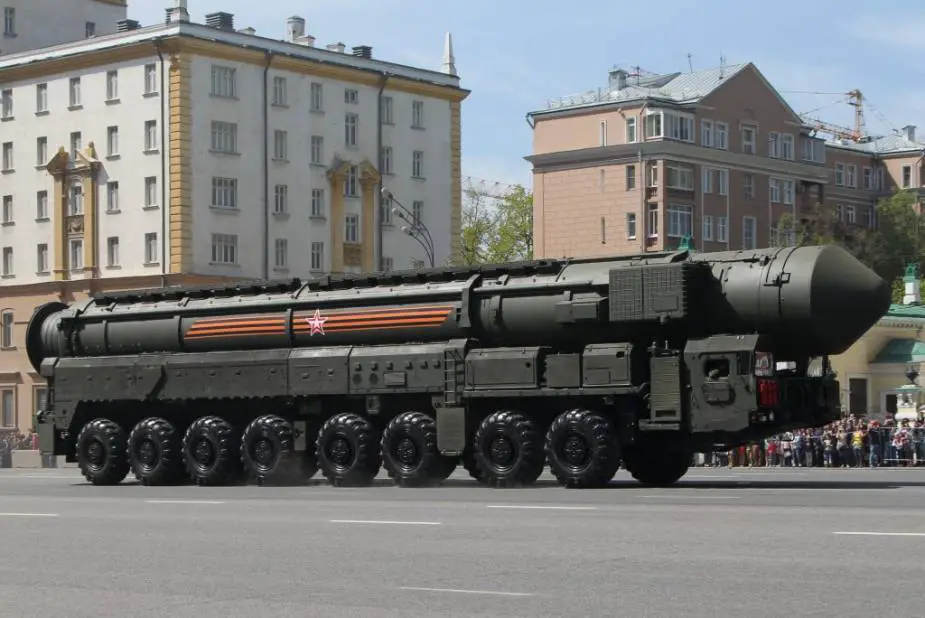Russian RS-28 Sarmat ICBM can carry several types of warheads
Voevoda R-36M2 intercontinental ballistic missile (ICBM) is one of the most powerful Russian nuclear deterrence. However, there is the task to create a modern ICBM that can replace Voevoda and break through missile defense, which constantly increases its capabilities. Sarmat RS-28 ICBM will do the job, the Military-Industrial Courier writes.
Follow Army Recognition on Google News at this link

RS-28 Sarmat ICBM (Picture source: Wikimedia)
The necessity to create a prospective silo-based strategic missile is due to several objective factors. The main one is that Voevoda is morally outdated. Its vulnerability to U.S. missile defense is higher than acceptable for modern strategic missiles. Most production facilities specializing in R-36M remained in Ukraine thus impeding the upgrade of Voevoda. Therefore, it was a logical decision to develop a new missile capable of breaking through the missile defense.
The first disagreements in the concept of the new missile-related to the type of the power plant. Supporters of solid-fuel engines insisted that a decreased throw weight promotes the creation of a light ICBM carried by a mobile launcher. Liquid fuel supporters agreed that a solid-fuel option is less vulnerable at the boost section, however a liquid-fuel missile can carry more active protection means and is better protected at the final stage of the trajectory.
The discussion ended when a technical assignment was issued for the design of both options. Liquid fuel supporters won in the final end. Sarmat RS-28 is powered by the latest RS-99 engines, which are a deep upgrade of the RD-263 power plant. Sarmat project was entrusted to the Makeev State Missile Center.
RS-28 Sarmat will be the main silo-based ICBM in Russia. The Strategic Missile Forces do not have to build new silos for it, as RS-28 will be adapted to the existing ones. The increased thrust of the RS-99 engine decreases the time of the active stage of the flight and thus complicates the operation of hostile missile defense. ICBM is most vulnerable at the active stage.
The combination of the new engine and some types of payload can increase the flight range. Yuri Borisov, deputy defense minister in 2014, said RS-28 is distinguished by the absence of distance restrictions. “Sarmat can fly not only by the shortest trajectory, but it can also fly via the North and South Poles,” he said.
RS-99 power plant accelerates Sarmat to a speed that is slightly slower than required for the orbiting of the throw weight. It approaches the target by a trajectory that reduces to zero the Pentagon efforts to protect the USA against a nuclear attack. Only a missile defense along the perimeter of ground and sea US borders can stop Sarmat, but it is absolutely unreal financially.
The Makeev center considered three options of an RS-28 reentry vehicle. One is armed with multiple maneuvering warheads, the other is multiple-warhead with individually targeted units that can effectively break through missile defense, and gliding cruise reentry vehicles. Over ten gliding Avangard cruise vehicles can be used as the warhead.
The arming of Sarmat with Avangard maneuvering vehicles deserves most attention. Open sources said Avangard develops a speed of Mach 27. The existing US air and missile defense is incapable of intercepting targets at such a speed.
Most experts agree that the number of heavy ICBM would remain in the same limits. It means one Voevoda will be replaced by one Sarmat.
The Russian Strategic Missile Forces will get an ICBM with an exclusive potential capable of developing it into a new effective instrument of strategic deterrence.
© Copyright 2021 TASS / Army Recognition Group SPRL. All rights reserved. This material may not be published, broadcast, rewritten or redistributed.




























